28 Classroom Organization Ideas to Make Your Year Easier
All Posts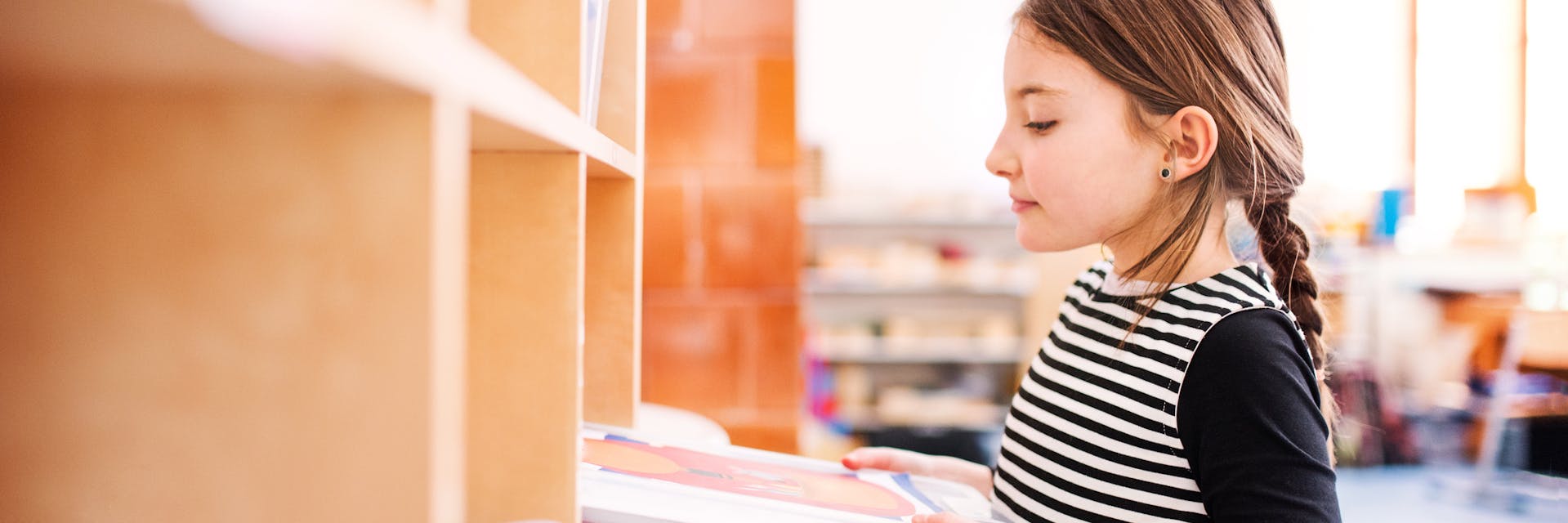
Written by Laney Kennedy
Reviewed by Meredith Melvin, B.Ed.
Category
- Teacher Resources
Contents
After a long day of teaching, the last thing you want to do is stick around all evening to clean up and prepare for the next day.
Luckily, there are plenty of ways classroom organization can save time and resources — so your whole day runs smoothly.
We gathered the best classroom organization ideas created by teachers like you, and shared for teachers like you.
Don’t let a messy, unorganized classroom take up all your time. Take a weight off your shoulders and try these 28 easy classroom organization hacks.
Classroom library organization
Keep your books and papers tidy with these 7 tips to organize your classroom library!
1. Use book bins
Traditionally organized bookshelves are great, but the time it takes to find the book you’re looking for? Not so much.
To make things easier, use book bins. Grab some labelled bins and organize your books any way you want. Alphabetically, by reading level, by subject — the choice is yours!
In the video above, teacher and YouTuber, Early EDventures, shows how she organized her books by genre. Now she can easily find specific books for lessons, and her students can choose which kinds of stories they want to read.
You’ll need:
- Individual boxes or bins
- Sticker labels (or paper and glue)
2. Store papers in library pockets
Keep track of all your papers with library pockets that contain related worksheets and resources, like these DIY ones.
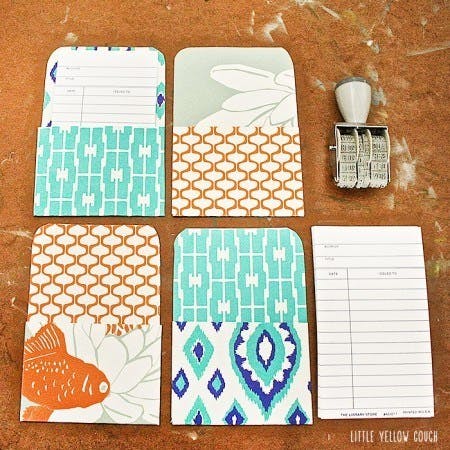
If you really want to take your organization to the next level, sort the library pockets into book bins. You’ll have no problem finding the right one when you need it!
You’ll need:
- Manila envelopes, file folders or portfolios
- Sticker labels (or paper and glue)
3. Laminate worksheets and reuse them
When teaching basic concepts through repetitive practice, this trick is a lifesaver — and a paper-saver.
Laminate any worksheets you want to reuse, keep them in your library pockets, and give students dry-erase markers to fill them out. Then when they’re done, erase and reuse!
You’ll need:
- Worksheets
- Laminator (or take your worksheets to a business that offers laminating)
- Dry-erase markers
- Cloth or eraser
4. Color-code your books
With a class of multiple students, keeping track of individual workbooks, notebooks and journals can feel impossible.
To overcome this, try color-coding the spines of each book to categorize them. Or, use different colored binders and bins to store them.
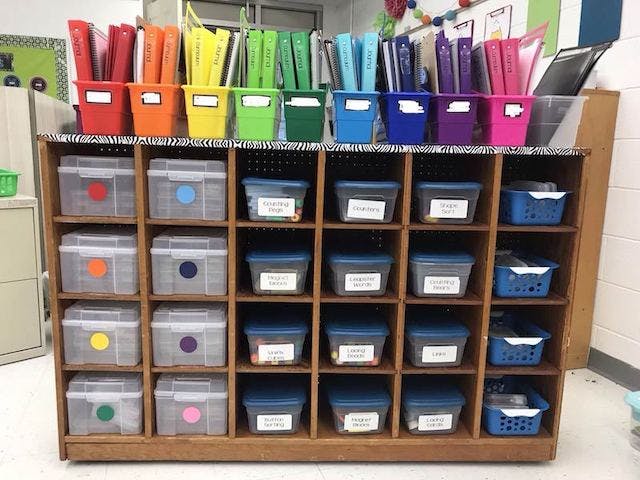
Split your students into different “color groups” to make collecting, handing out and finding specific students’ books a breeze!
You’ll need:
- Colored duct tape, washable paint, or binders
5. Store extra anchor charts in a laundry hamper
Unless you have infinite wall space in your classroom, it’s not feasible to keep every anchor chart up all year. But, chances are, you’ll want to reuse them later.
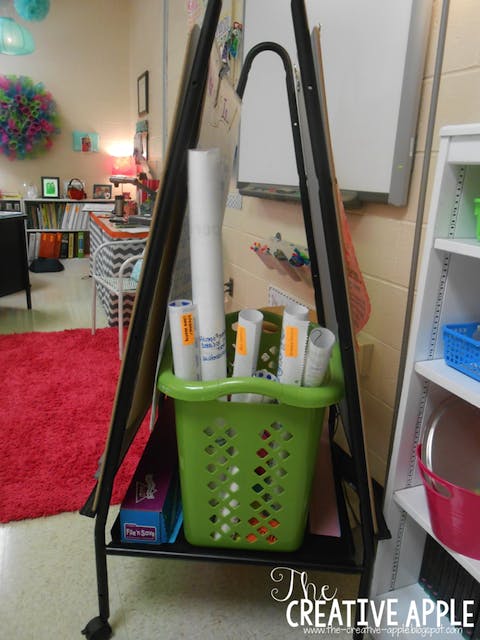
Try this trick: laminate your anchor charts, roll them up and store them in a laundry hamper.
This teacher also labeled her anchor charts to make them even simpler to find. This idea makes it super easy to retrieve old anchor charts. Plus, your hampers will be nice decorations in the classroom!
You’ll need:
- Tall laundry hamper
- Laminator
- Labels
- Clothespins (to secure labels)
6. Replace paper with dry erase placemats
With all the activities you do in one school day, you can waste tons of paper. Instead, stick dry erase placemats on tables and desks. Students can write out their thoughts, erase, and repeat!
Plus, you never have to hand them out — they’re always right there for your class to use.
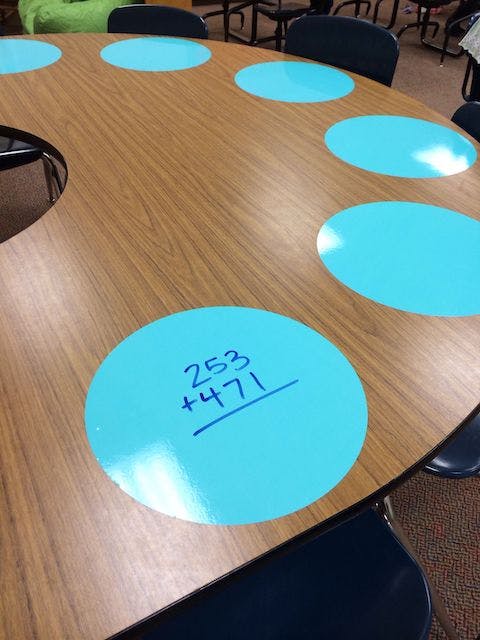
You’ll need:
- Large dry erase tabletop stickers (or laminated paper and double sided tape)
- Dry erase markers
- Cloths or erasers
7. Use storage clipboards for individual students
Keep track of individual student goals and learning materials with storage clipboards.
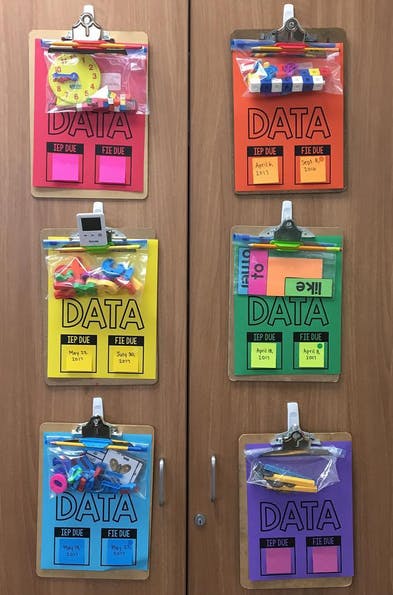
This idea is especially great for teachers with lots of IEP students. Quick access to personalized materials will help you support student needs right away.
You’ll need:
- Storage clipboards
- Paper
School supply organization
Now that your library is organized, what do you do with your glue sticks? Pencils? First aid items? Try these 10 tips for organizing supplies and materials!
1. Color-code your electronics
We know electronics are never fun to lose. Fortunately, you can avoid this with some simple color-coding!
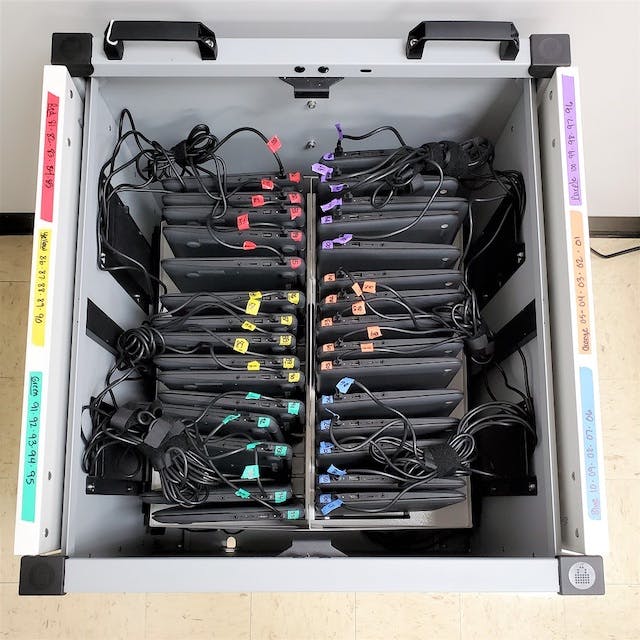
This teacher color-coded her Google Chromebooks, so every device had a designated spot and a matching cable. And, as an added bonus, the pop of color made her cart look fantastic!
You’ll need:
- Colored tape
- Number labels
2. Make a designated supply station
Put an end to the mystery of the disappearing stapler, once and for all!
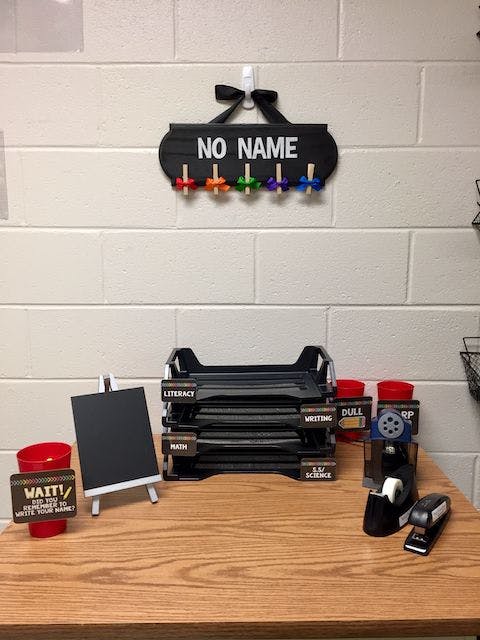
Give your supplies their own designated station and make sure each article is accounted for at the end of the day — a great task for one of your students!
When students are ready to turn in their work, they will know exactly where to find the stapler, tape or even a pencil to ensure their name is written on their work!
You’ll need:
- Labels for supplies
- List for tracking supplies
3. Decorate your classroom with a teacher toolbox
Say goodbye to sorting through a sea of pencils and markers in the search for one yellow highlighter. Instead, store your supplies in their own designated drawer and label it.
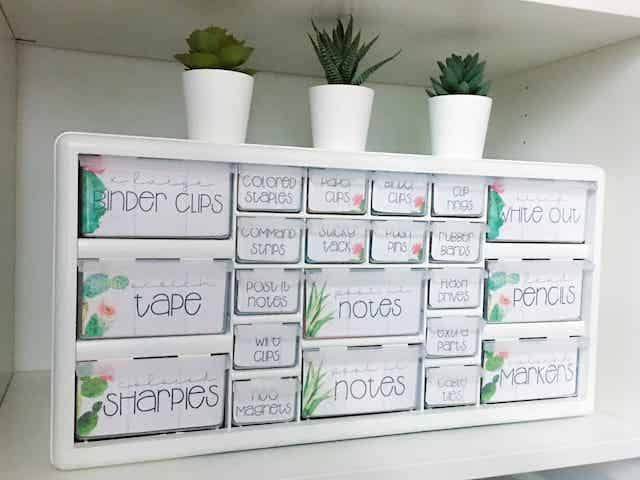
Try a teacher toolbox template like this one!
The best part of the teacher toolbox is that it's decorative and useful. Your classroom looks great and you’re never fumbling for the things you need. Win-win!
You’ll need:
- Bins with lids or drawer sets
- Sticker paper, sticker labels or regular paper and glue
4. Label your lids
It's another all-too-common vanishing act. Glue sticks, markers, white-out, you name it — if they come with lids, those lids will likely go missing.
Instead of constantly replacing these items, try labeling your lids with corresponding labels on the item.
This will help students to be mindful of matching the numbers on the item and lid before putting the items away.
You’ll need:
- Numbered labels (or a sharpie)
5. Store pencils in toothbrush cases
This idea is a great alternative to keeping spare pencils loose.
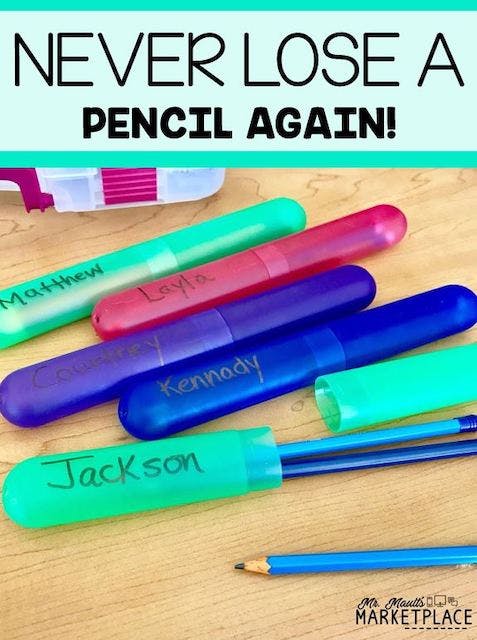
Put pencils for each student in their own toothbrush travel cases to contain and keep track of pencils with ease.
You’ll need:
- Pencils
- Toothbrush travel cases
- Sticker labels or a permanent marker (if you want to add student names)
6. Create a DIY medical kit
Keep a decorative medical kit in your class for small issues that don’t require a visit to the nurse.
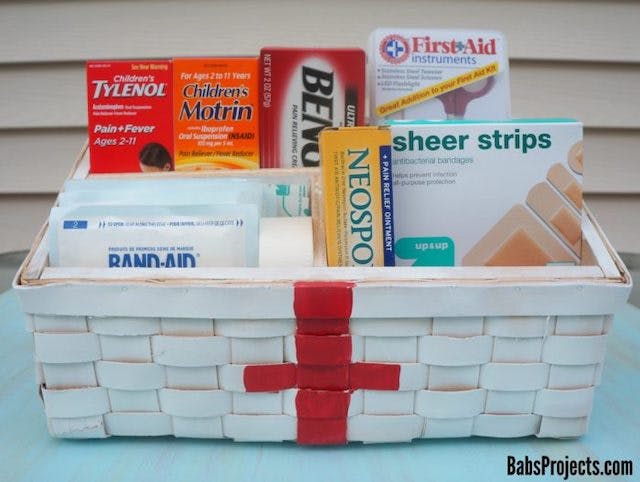
This classroom medical kit is just an example. Be sure to double-check with your school nurse and/or school policies regarding medication administration.
Create a kit that’s your own style and let it complement your classroom theme!
You’ll need:
- Storage crate or box
- Paint
- Stencils or sticker labels (for labelling the kit)
- Basic medical supplies -- ex. bandages (of various sizes), tissues, thermometer, tweezers, hand sanitizer, distilled water
- Student allergy list
7. Think outside the storage box
Sometimes you can find a perfect fit when you look beyond traditional classroom storage.
For example, kitchen storage items can be effective for storing classroom supplies. This photo shows a coffee pod carousel used to store Play-Doh tubs.

8. Promote desk organization
“But I can’t find my [school supply that’s definitely hidden somewhere in a messy desk]!”
Organization shouldn’t be your responsibility alone. Provide a handy guide on an anchor chart to help students keep their desks neat and tidy, and encourage individual accountability.
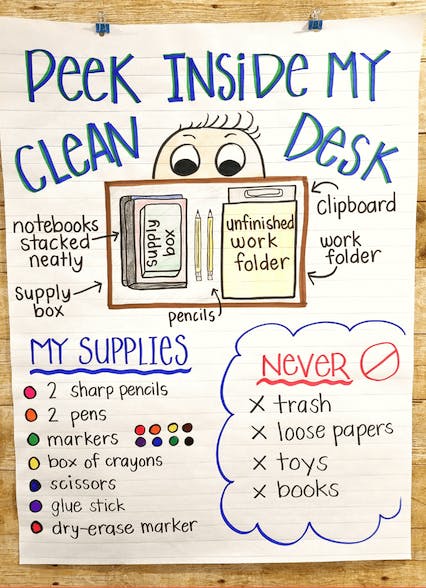
You’ll need:
- Anchor chart paper
- Markers
9. Turn chairs into storage spaces
Another way to organize students’ individual supplies is to go beyond the desks and use chairs as storage.
Place velcro on the backs of student chairs and on important supplies like rulers, number lines, multiplication charts and more.
You’ll need:
- Sticky-back velcro tape
- Laminator (if adding velcro to printed sheets)
10. Keep an emergency supply
You might not want to tell your students about this particular idea (unless, of course, you feel like sharing candy with 20 kids).
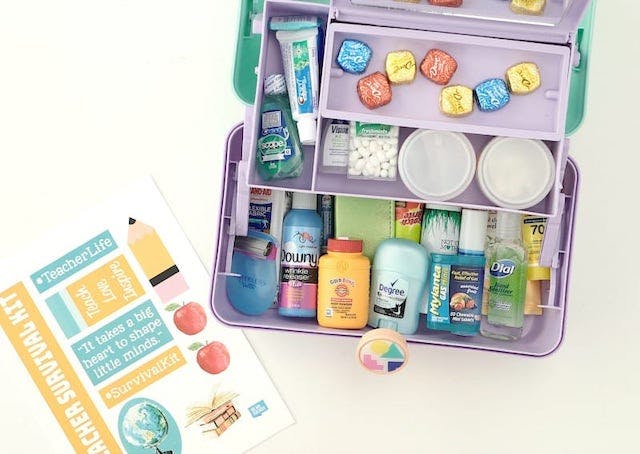
These “teacher survival” kits can be a great gift for colleagues, or just a way to help you through that post-lunch exhaustion.
Reminder: If your survival kit has any medication included, keep your kit locked and/or out of reach of students.
You’ll need:
- Small sealable containers
- Sticker labels (or paper and glue)
- All the candy!
Tracking student information
It’s your job to ensure that students are safe, happy and learning more every day.
Luckily, these 5 tips for keeping track of student information can help you take care of such an important task!
1. Use lanyard lists for essential info
Keep important lists on hand at all times with DIY lanyard lists.
Not only do you save on paper, you’ll also have a much easier time finding the information you need right away.
You’ll need:
- Laminator
- 1-hole punch
- Lanyard or keyring
2. Make a systematic student data binder
Student data is plentiful and always changing. Your system for filing data should reflect this.
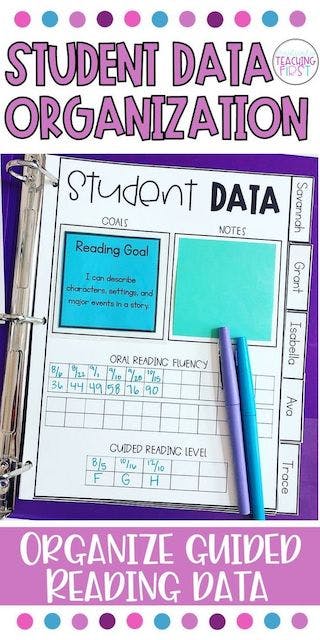
A thorough student data binder like the one above should include all your student data forms, tabs with student names and blank spots to easily switch goals and add new notes.
You’ll need:
- 3-Ring binder
- Divider tabs
- Sticky notes or adhesive pockets
3. Make a yearly birthday board
Never miss a birthday with adorable birthday boards to remind you and your students whose birthday comes next.|
For a design like this one, you’ll need:
- Small wooden gingerbread men
- Hooks and eyes
- Board and vinyl lettering
- Paint
4. Track patterns with an attendance record book
With an attendance record book, you won’t miss a beat.
Log student names and attendance on each day of the year. Then, you can easily look back and track attendance patterns for future reports.
You’ll need:
- Log book or notebook, or an online log book
- Colored pens/markers/highlighters
5. DIY hall passes
Make one-of-a-kind hall passes so everyone knows which students belong to your class!

DIY passes make it easy to keep track of why students left class. Plus, they look much nicer (and are much easier to clean in between student use) than regular hall passes.
You’ll need:
- Laminator
- 1-Hole punch
- Lanyards
Organizing your day
Try these 5 organization tips for lesson prep and daily schedule tracking!
1. Keep a morning cart by your classroom door
Meet your new morning sidekick: the morning cart.
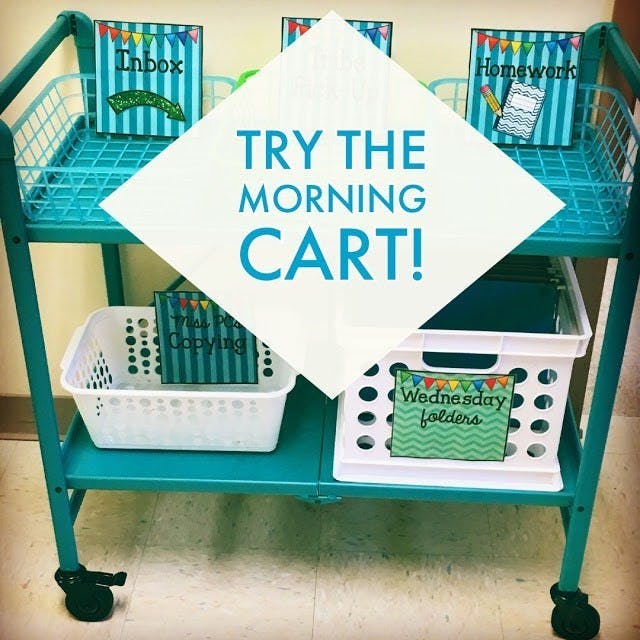
Add anything you need to your cart — for example, a space for students to hand in and pick up work, your day’s lessons and resources or any supplies your students will need for the day.
Place the cart outside your classroom door, so students can be ready for the day before they even step into the room. Suddenly, morning routines will be a breeze!
You’ll need:
- Utility cart
- Baskets
- Labels for baskets
2. Use a hanging calendar
Effortlessly change and track the date with this handy accessory for your wall.
Now, instead of writing out the date every morning, just flip your calendar to the next day! You’ll need:
- Hanging bar or rod
- Binder rings
- Labels
- 1-Hole punch
3. Display the daily schedule with magnets
This makes a great addition to your hanging calendar, while also making it incredibly easy to display your schedule and make changes as needed.

For a magnet schedule like this one, you’ll need:
- Labelled magnets or chalkboard magnets
- Chalk
4. Make a sub tub
You can’t always plan for your absent days. Sometimes things pop up out of nowhere, and that’s why it’s always best to be prepared.
Make a sub tub to ensure your substitute lesson plan for the following day is always ready to go.
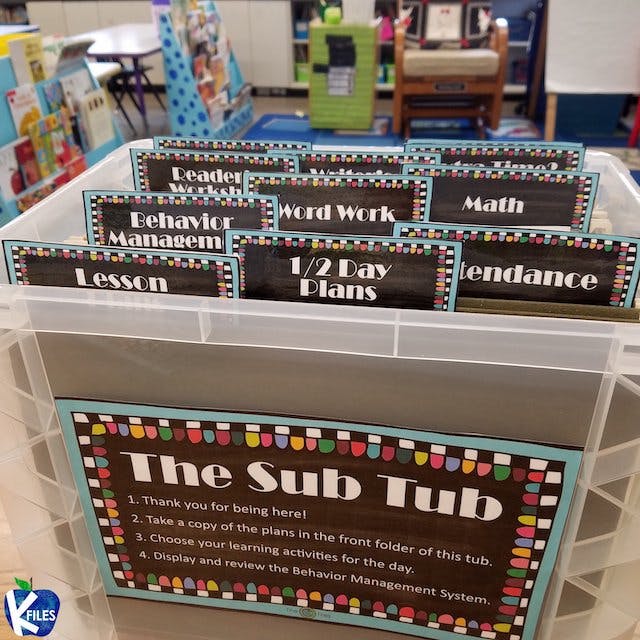
Once you have your sub tub, get into the habit of updating it every evening before you leave — just in case. Include anything you think will help your substitute teacher understand their responsibilities for the day.
You’ll need:
- Basket or tub
- Labels
- Schedules, outlines and supplies
5. Plan lessons with a digital rotation chart
Digital rotation charts are helpful because:
- They’re harder to lose — you’ll always know where to access the schedule and plan.
- They keep students on track — Display your schedule so students know exactly where they’re going next and what they need to be working on. This way, as soon as one group gets done playing Prodigy, they can swiftly move on to their independent work time without any confusion or hesitation.
- They’re easy to organize — With a digital format, you can efficiently color-code, add links and sort students into groups.
Try it and see for yourself!
You’ll need:
- A digital presentation program such as Google Slides or Keynote
These classroom organization tips will keep your work day productive and your classroom looking great. But don’t forget the most important one:
Set boundaries for yourself
You have so much to organize every day — it can become overwhelming at times. So take some time for yourself and try to set limits. Right now, it's more important than ever to make sure you put your health first.

An organized school day leaves you more time to do what you’re best at: shaping young minds, so every child you teach can reach their fullest potential.
Try out your favorite classroom organization ideas from this list and share some of your own tricks to inspire other teachers.
Not sure where? Join the Prodigy Teacher Facebook Group and join 6.5k likeminded educators who discuss Prodigy, teaching tips and more.
Happy organizing!
Want to set a new course for learning in your classroom this year?
Prodigy is an engaging game-based learning platform that’s curriculum-aligned and easy to use for educators and students alike. It’s used by more than 50 million students, teachers and parents around the world.
Use your teacher account to send Assessments and view student progress, all while kids have tons of fun playing Prodigy Math Game and exploring new virtual worlds!
Help your students love learning this year.



